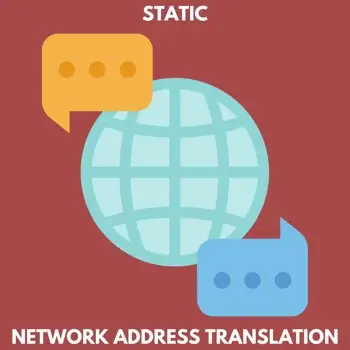What Is Static NAT (Static Network Address Translation)?
A home router configured with network address translation facilitates communication between the private network and the external Internet. The technique allows multiple devices on a local network to share the same network address. Static NAT is one form of NAT, pairing each IP address with a unique public address. In this article, learn what static NAT is, how it works, and its benefits.
What is static NAT?
Static network address translation, or static NAT, is a type of NAT that maps a private IP address to a public IP address on a one-to-one basis. This technique guarantees that a specific internal device always uses a single public IP address when communicating with external networks, such as the Internet.
Technically, NAT is a way to translate addresses from private IPs (non-routable) to public IPs (routable). It enables more devices on a private network to access the Internet using a single public IP address. This conversion occurs based on the NAT table maintained by the router.
A NAT table is where NAT usually keeps a record of private-to-public IP and port mappings. For example, a private IP like 192.168.10.1 always maps to the same public IP, say 203.0.113.10, allowing response data packets to return to the appropriate device in the internal network.
Static NAT provides a 1:1 mapping. This means that you're not able to map a public IP address to more than one private IP address. Because of this, you need an equal number of public addresses as private addresses. The public address is the same for each consecutive connection with static NAT.
Features of static NAT
For dynamic NAT, the public IP changes based on availability. Static NAT, by contrast, ensures the mapped IP remains constant. The main advantage of static NAT is the fixed mapping. It ensures that external devices consistently reach the same internal resource.
This translation method is ideal for companies looking for uninterrupted access to certain services or applications from the Internet. Many servers hosting web services, email, or File Transfer Protocol (FTP) operate under static NAT deployment.
Static NAT hides the internal network structure to enhance security. External users only see the public IP addresses, shielding internal systems from direct exposure.
But cases like misconfiguration of your NAT-enabled device or firewall can lead to full exposure of the devices on your private network to which the public IP maps.
Another important aspect of static NAT is that it is less scalable. Since each internal IP requires a dedicated external IP, it can quickly consume available public IP addresses in larger networks.

How does static NAT work?
In a typical setup, a network administrator manually configures a one-to-one mapping on a NAT device, which is usually a router or firewall. Each private IP address within the local network is assigned a unique public IP address. This configuration is done in the router’s command line or graphical user interface.
When a device with a private IP address sends a request to the Internet, the NAT device checks the NAT table to replace the private IP address with the corresponding public IP address.
When a response comes back from the Internet to the public IP, the NAT device translates the public IP back to the private IP address, allowing the traffic to reach the intended internal device.
Static NAT allows for bidirectional communication. This implies that both inbound and outbound traffic can be translated to enable devices within the private network to initiate connections to external devices and vice versa.
Imagine you have a web server within your private network with a private IP address of 10.0.0.1. You can make it accessible from the Internet using a public IP address like 203.0.113.1.
The NAT device will handle all the necessary translations to ensure that requests to the public IP address are correctly routed to the web server and that responses from the web server are correctly routed back to the external users.
Boundaries of static NAT
Understanding the limits of static NAT is essential for efficient network management. This NAT type involves two key layers:
- Traffic direction. It allows you to specify the interface, zone, or routing instance from which the traffic originates.
- Packet information. It can include both source and destination addresses as well as port details.
When dealing with Application Layer Gateway (ALG) traffic, avoid using static NAT rule options for source addresses or ports, except for FTP ALG traffic. These options can result in session failures because the random nature of source port values might not align with the static NAT rule.
However, the source-address option is useful for FTP traffic, as FTP protocols can provide the matching source address for NAT.
When configuring a static network address translation rule with both source and destination addresses, the rule must match traffic in both directions.
Static NAT is bidirectional, so it works in both directions. The rule matches the traffic’s destination address in one direction and reverses the match in the opposite direction.
The system selects the most specific rule if multiple static NAT rules overlap. For instance, if two rules share the same source and destination IPs, but one rule specifies a zone, and the other specifies an interface, the interface rule takes precedence. Interface matches are more specific than zone matches, and zone matches are more specific than routing instance matches.
Static network address translation doesn’t support overlapping addresses and ports, especially for ALG traffic. Mapping one external IP to multiple internal addresses could cause issues. Therefore, it’s best to assign different external IPs to different internal servers, particularly for applications like FTP.
Also, static NAT rules take priority over destination NAT rules. Similarly, reverse mapping of static NAT rules overrides source NAT rules.
Benefits of using static network address translation
Static NAT offers several advantages, including:
- Multi-network connections. Static network address translation is often used to connect two networks with overlapping IP ranges. If your company buys another and their IPs are all in the 10.0.0.0 range, you can use static NAT between these networks so they work together.
- Public accessibility. The mapping of the public to hosts inside the internal network suggests that you can have a device on your private network that exists on the Internet with its own real IP.
- Improved security. The primary purpose of static NAT is to stretch the number of computers able to work off of a publicly routable IP address and to hide the private IP addresses of hosts on your local area network.
- Optimized performance. In computer networking, static NAT optimizes network performance by allowing devices within the network to establish persistent connections with external servers.
- Simplified management. It provides a predictable mapping between internal and external IP addresses. Network administrators can troubleshoot network connections with ease.
- Compatibility with legacy applications. Some legacy applications may require static IP addresses for proper functioning. Static NAT ensures that these applications can continue to operate as expected.
However, it's important to note that static NAT also has some drawbacks:
- Limited scalability. Static NAT requires a fixed number of public IP addresses, which can be a limitation for organizations that need to support a handful of devices within your private network.
- Increased management overhead. It increases the management overhead involved in assigning and maintaining external IP addresses.
- Resource utilization. Public IPs are a limited resource; static NAT can quickly deplete available IP addresses.
Differences between static and dynamic NAT
Static NAT and dynamic NAT are both network address translation (NAT) methods. They do the same thing: to map private IP addresses to public IP addresses.
Dynamic NAT uses the concept of a pool of public IP addresses. Put simply, addresses are mapped from an assigned pool on the "remote" side of the NAT wall.
Here are the key differences between static network address translation and dynamic network address translation.
| Feature | Static NAT | Dynamic NAT |
| Function | Permanently assigns a public IP address to a private IP address. | Temporarily assigns a public IP address to a private IP address and releases it once the communication session ends. |
| Configuration | Network administrators manually configure IP mapping on static NAT. | Randomly maps the private IP addresses with a pool of IP addresses configured on the NAT device based on first-come, first-served basis. |
| Configuration complexity | Easy to configure - one-to-one fixed mapping between internal and external IP addresses. | User creates an access list and configures the NAT pool. |
| External IP requirement | Requires one external IP address for each internal device. | Can use a pool of external IP addresses for multiple internal devices. |
| Security | Less secure since the internal IP is always mapped to the same external IP. | More secure because external IPs change frequently. |
| Session continuity | Guaranteed, as the external IP is always the same. | No guarantee of keeping the same external IP for a session over time. |
| Use cases | Useful for services that require consistent access. | Commonly used for general internal network access to the Internet. |
Configuring static NAT on routers
Here are step-by-step instructions for configuring static NAT on different types of routers, specifically Cisco routers, as they are widely used in many networks.
To configure NAT, first access the router command-line interface (CLI). Connect to your router via console cable, SSH, or Telnet. Then enter your username and password to access the command-line interface.
Go to global configuration mode and define the router's internal interfaces. Identify which interface is connected to the internal network and use the following command:
Router(config)# interface <inside-interface>
Router(config-if)# ip nat inside
Router(config-if)# exit
Next, define the router's internal interface and determine which is connected to the external network of the Internet. Run this command:
Router(config)# interface <outside-interface>
Router(config-if)# ip nat outside
Router(config-if)# exit
After running the command, configure static NAT mapping by using this command:
ip nat inside source static [internal_ip] [external_ip]
Check the NAT configuration with the command show ip nat translations to verify the configuration. Once verified, save the configuration and ensure that your changes persist after a reboot.
Troubleshooting common issues with static NAT
While a valuable tool, static NAT can sometimes cause issues. Most arise due to several factors, including misconfiguration, connectivity problems, or network conflicts.
- If you have incorrect NAT configuration, it means that the internal and external IP addresses in the NAT table are not mapped correctly. To solve this issue, verify that the IP addresses are valid.
- If you have conflicting NAT rules, it means multiple NAT rules are conflicting with each other, causing the desired traffic translation to fail. To solve this issue, prioritize rules based on the desired behavior.
- If you have firewall restrictions, these block the traffic required for static NAT to function properly. Ensuring the rules allow traffic to pass through will fix this problem.
- If your external IP is not reachable from outside, this means your external IP address mapped to the internal resource might not be reachable from the Internet due to upstream ISP issues. To solve this issue, run ping or traceroute commands to verify connectivity to the external IP.
Frequently asked questions
Can I use static network address translation with IPv6 addresses?
No. IPv6 instead eliminates the use of NAT. The need for NAT is significantly reduced due to the vast address space available.
Is static NAT supported by all operating systems?
Not all operating systems provide built-in static NAT functionality. Static NAT is the oldest method and its support varies by operating system and network equipment.
How does static NAT improve security?
It limits the number of public IP addresses exposed to the Internet.

